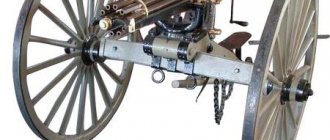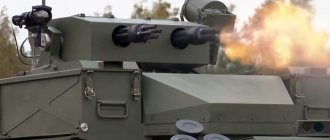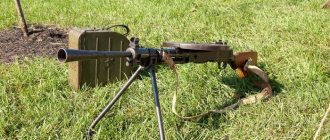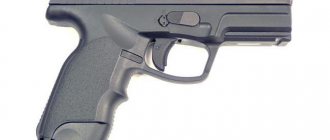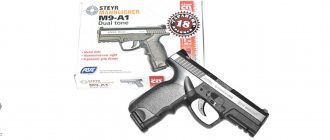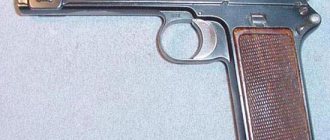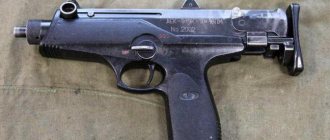Steyr-Solothurn S1-100. A submachine gun ahead of its time
A new type of cartridge, more powerful than pistol cartridges, but not as powerful as rifle cartridges, made it possible to create weapons that are lightweight, reliable and highly effective. We are talking about machine guns (assault rifles).
When the Nazis came to power in Germany, this became the impetus for the rapid development of the military-industrial complex. The Wehrmacht was awaiting rearmament, taking into account the concepts available at that time for solving the main task: to bring the German army to a leading position throughout the world. The high command carefully analyzed the prospects for the development of equipment and weapons and developed a strategy for re-equipping the German armed forces so that they would be able to conduct large-scale offensive operations in the future and have weapons more effective than those of a potential enemy.
Creation and development of the machine
According to war films, the fascist German invaders are presented to us as Wehrmacht soldiers, dressed in a Nazi uniform, a helmet and holding an MP.
The MP.38, as well as the MP.40 (a later model) turned out to be good PP, their characteristics were ahead of that era, which determined their extraordinary popularity. The appearance of this uniquely successful weapon was preceded by the S1-100 (MP.34) PP. The first PP with this marking was released in 1919.
The author of the creation of the S1-100 PP (later MP.34) was the talented German gunsmith Louis Stange. This man managed to make the world's first submachine gun, called MP.19. Previously, such weapons did not exist. There were only pistols, rifles and machine guns.
According to the terms of the Treaty of Versailles, Germany did not have the right to mass produce weapons in its country. This led to the fact that a very interesting development was shelved for almost ten years...
What is significant is that Stange’s concept from 1919 remained relevant decades later. At that time, the German company Rheinmetall merged with the Swiss Wafenfabrik Solothurn. The Germans bought the production of the Swiss and, legally, got the opportunity to make weapons on their territory.
In a very short time, the existing developments of the S1-100 concept were improved, and the technical documentation was updated taking into account scientific and technological progress. It was only necessary to launch the required capacities, after which we could begin mass production of weapons. Thus, with the Austrian company Steyr they created a company called Steyr-Solothurn Waffen AG. Literally a year later, the initial batch of machine guns was released. Whatever you say, the pace is record-breaking!
The Austrian police were the first to receive a submachine gun marked MP.30. Soon, PP began to be exported to Latin America and Europe. Some Asian countries also bought it willingly. Very important: the consumer could purchase weapon models with the ability to use different calibers of ammunition. The Steyr-Solothurn S1-100 has become very popular due to its high degree of destruction of the enemy and ease of operation in different climatic conditions.
This model of submachine gun was produced until 1942, when Austria and Germany were already united. The only thing that has changed is that modified 9x19 ammunition was made for the PP, which received the marking MP.34(b).
Design features of PP
Of course, if you compare the Steyr-Solothurn S1-100 today with those types of small arms that exist now, the weak points of the “old man” will immediately be visible. It cannot be called ideal. But we should not forget that we are talking about weapons designed at the beginning of the last century. It was thanks to this concept that other weapons designers began to exploit and develop the idea of a submachine gun. For many years the Steyr-Solothurn S1-100 has been a role model.
Note that the S1-100 was made based on the operating principle of automatic blowback. The shot was fired with the shutter open. This approach made it possible to produce weapons with the ability to use cartridges with different characteristics. To do this, it was enough to install a different barrel and adapt the bolt.
What was special about the submachine gun was the way the recoil spring was located. It was placed in a wooden stock, which made it possible to reduce the size of the receiver, but eliminated the possibility of using a folding stock in the S1-100.
Thirty-two rounds were fed into the PP receiver on the left side. The chamber neck had a secret. Since the clip fit into a slotted hole in the neck from below, it became possible to reduce the time for replacing the magazine.
The bayonet mount was made in an original way - on the side. True, it must be admitted that it was not easy to use it in hand-to-hand combat, since the magazine and fire mode translator, located on the left side, were in the way.
Fire characteristics
The main feature of submachine guns that are available now is their compact size. But more than a hundred years ago, PPs were completely different. The barrel then had a length of about 200 millimeters. The total length of such a weapon was 85 centimeters, weight without ammunition was 4.2 kg.
The rate of fire of the first SMGs was generally stable, but depended on the ammunition used. The fire was carried out at a rate of 400-500 rounds, again taking into account what cartridges were used. The greatest efficiency in firing range was demonstrated by the Steyr-Solothurn S1-100, designed for Mauser cartridges (9x25). They could hit an enemy located at a distance of almost three hundred meters. It is clear that aimed fire in this case was difficult to conduct.
In terms of weight and dimensions, the Steyr-Solothurn S1-100 was comparable to a carbine, or even a rifle. However, the fact that it had 32 rounds of ammunition and allowed automatic fire made it indispensable in close combat.
Pros and cons of a submachine gun
The main advantage of the Steyr-Solothurn S1-100 was its reliability and the ability to use different cartridges. Of course, the constructive solution associated with equipping a magazine from clips is also interesting.
It is important that the submachine gun was easy to maintain and easy to clean. I lifted the barrel cover and gained access to all the main mechanisms.
As such, there were no fundamental shortcomings in the submachine gun. In principle, even the large weight of the weapon can be considered a positive thing, given that it helped the stability of fire.
The definite disadvantage was the length of the PP and the location of the bayonet. It was certainly not a weapon for hand-to-hand combat.
To summarize, it should be said: the Steyr-Solothurn S1-100 SMG is an outstanding development that largely determined the further development of small arms.
Story
After World War I, the production of submachine guns like the MP-18 was banned in Germany. However, in violation of the Treaties of Versailles, a number of experimental submachine guns were secretly developed, among which was the MP19 created by Rheinmetall-Borsig.
Waffenfabrik Solothurn AG in 1929
, whose task was to develop, produce and sell a new submachine gun on the foreign market.
However, its production capacity was not enough, so it was decided to use a subcontractor in the person of the Austrian concern Steyr-Daimler-Puch AG
, the largest weapons manufacturer in Europe.
Production of the serial version of the submachine gun under the name Steyr-Solothurn S1-100 began in 1930 and continued until the end of 1940. The submachine gun was sold on the world market on behalf of the joint company Steyr-Solothurn Waffen AG
, which had its headquarters in Zurich. The production itself was located mainly in Austria.
The Steyr-Solothurn S-100 was produced in calibers 9x23 mm Steyr, 9x25 mm Mauser Export, 7.63x25 mm Mauser, 7.65x21 mm Parabellum, 9x19 mm Luger, .45 ACP (with additional front handle). A number of models allowed the installation of a bayonet. The 32-round magazine receiver was located on the left side of the weapon. The sight is sectoral with markings from 50 to 500 m, in increments of 50 m. A very limited number of submachine guns were produced with a long (600 mm) barrel. Early samples were equipped with a block for installation on a tripod machine and in this form were called Steyr-Solothurn S17-100.
The main buyers of the Steyr-Solothurn S-100 were Chile, El Salvador, Bolivia and Uruguay, and it was used in the Gran Chaco War. In 1935, Portugal purchased and adopted submachine guns under the symbol “m/935” in 7.65x21 Parabellum caliber. Japan and China made limited use of the 7.63x25 Mauser variant throughout World War II.
The Steyr-Daimler-Puch AG concern also produced this submachine gun for Austria, where it was in service with the police and gendarmerie as the Steyr M.30 in 9x23 mm Steyr caliber. The Steyr M.34 chambered for the 9x25 mm Mauser Export cartridge was produced for the Austrian army. Since the end of 1939 (after the Anschluss of Austria), M.34 submachine guns received the German index MP.34(ö) (where “ö” is from the German österreichische - “Austrian”), their production for Wehrmacht units continued until approximately 1940 , also the remains of this modification in caliber 9×19 Luger
in 1942 they were purchased by Portugal, where they received the index “m/942”.
In service
- Austria Austria - adopted by the police and gendarmerie as the Steyr M.30
chambered for
9 mm M.12
(9 x 23 Steyr), and in 1934 - entered into service with the army as
the Steyr M.34
chambered for
9 mm M.34 ( Mauser)
(9 x 25 Mauser), with the ability to mount an M1895 bayonet)[1]; in addition, it was produced for export for all the main military pistol cartridges of that time - 9 mm Parabellum, 7.63 mm Mauser, 7.65 mm Parabellum, .45 ACP. - Portugal Portugal - in 1938, a version chambered for 7.65×21 mm was adopted (under the name m/938
, in 1942 - a version chambered for 9×19 mm (under the name
m/942
). Used during the Portuguese colonial wars 1960s - 1970s in Africa[1]. - El Salvador El Salvador - in the 1930s, a batch of S1-100 submachine guns was purchased[3]
- Third Reich - after the Anschluss of Austria in 1938, submachine guns of the Austrian army came into the possession of the German authorities, and production of weapons continued under the name MP34(ö)
until 1940. Entered service with the Waffen SS, Wehrmacht rear units, and individual Luftwaffe and police units[1]. During the war, due to difficulties encountered in providing Wehrmacht units with non-standard ammunition, most submachine guns were transferred from the Wehrmacht to police units[4] - The independent state of Croatia - a huge number of units of these weapons were at the disposal of the Croatian household [5].
- Empire of Japan - a number of S1-100s were used by Japanese Army units during the war in China[4]
Notes
- ↑ 1234567
Ilya Shaidurov. The unknown and famous Louis Stange (part 1) // “Master Gun” magazine, No. 12 (165), December 2010. pp. 22-35 - ↑ 12
Popenker M.R., Milchev M.N. World War II: The Gunsmiths' War. M.: Yauza, Eksmo, 2008. p. 285 - ↑ 1234567
Popenker M.R., Milchev M.N. World War II: The Gunsmiths' War. M.: Yauza, Eksmo, 2008. p. 286 - ↑ 12
Steyr-Solothurn S1-100 // “War Machine”, vol. 1, issue 6. 1983. page 107 - [reibert.info/threads/chetniki.105668/page-11 Chetniks (Reibert.info forum)]
Links
- M.R. Popenker.
Rifles, carbines, machine guns Gewehr 1888 • Mauser 98 • Mauser 98k • Walther SK-39 • Gewehr 41 • FG-42 • MKb.42(W) • M30 Luftwaffe • SDK • Grossfuss Sturmgewehr • Gewehr 43/Karabiner 43 • HIW VSK • StG-44 • StG45 (M) • Knorr-Bremse • VK-98 • Volkssturmgewehr 1-5 • Wimmersperg Spz • Erma Volkssturmgewehr • Vollmer M-35 • Volkssturm-Mehrladegewehr Submachine guns MP-18/MP-28 • MP-34 • MP-35 • MP-36III • MP-38/40/41 • EMP-35 • MP3008 “Volks MP” Machine guns MG 08 • MG-08/15 • MG 13 • MG 34 • MG 39 Rh • MG 42 • MG 45 • VMG 1927 • Barnitzke • BSW Modell 1 • MG-81 • FWA Hobart Anti-tank weapons Grenade launchers Faustpatrone • Panzerfaust • Panzerschreck • 8.8 cm Raketenwerfer 43 “Pupchen” • Schiessbecher • Kampfpistole Anti-aircraft grenade launchers Fliegerfaust • Luftfaust-A • Luftfaust-B Mortars Granatwerfer 36 • 8-cm sGW34 • KZ 8 cm GrW 42 • 10 cm Nebelwerfer 35 • Granatwerfer 42 Flamethrowers Flammenwerfer 35 • Abwehrflammenwerfer 42 • Einstossflammenwerfer 46 Foreign weapons Rifles Vz.24/G24(t) • Gewehr 242(f) • Gewehr 306/Karabiner 561(g) • Gewehr 98(ö)/Gewehr 306/Karabiner 505(i) • Gewehr 249(a) • Winchester Model 1895 • Gewehr 301(f) • Selbstladekarabiner 455(a) • G289(j) • Gewehr 241(f) Submachine guns MP.34(ö) • MP.722(f) • MP.746(d) • MP.716(r) • MP.715(r) • MP.717(r) • MP.41(r) • MP .719(r) • MP.739(i) • MP.738(i) • MP.761(f) • MP.769 • SS-42 Machine guns MG26(t) • MG 07/12(ö) • MG30(t) • MG 099(i) • MG-126(b)/MG-147(j)/MG-156(f) • MG 157(f) • schwere MG 200(i) • MG 216(r) • 7.7mm sMG 230(e) • MG.105(f)/MG.201(n)/MG.257(f)/MG.257(p) • leicht MG 28(p) • MG35/36A Anti-tank rifles Solothurn S18-100 • Panzerbüchse 35(p) • PzB M.SS.41 Hand grenades Stielhandgranate • Eihandgranate • HL-Handgranate • Volkshandgranate • Panzerwurfmine • Nipolit • Glasgranate • Hafthohlladung Ammo 7.65x17mm • 7.63x25mm Mauser • 7.92x33mm • 7.65x21mm Parabellum • 7.92x57mm • 9x19mm Parabellum
Description
The weapon had an exceptionally high-quality design - all the main parts were made by milling from steel forgings, which gave it greater strength, high weight and cost. The receiver had a lid that hinged upwards and forwards, making disassembling the weapon for cleaning and maintenance very simple and convenient. The bolt was free, firing was carried out from an open bolt, the trigger allowed firing in single shots or bursts, the fire type translator in the form of a slider was located on the stock on the left. The return spring was located in the butt and was connected to the bolt by a long push rod. The safety was made in the form of two buttons on the cover of the bolt box, which, when pressed, fixed the bolt in the front or rear position.
The barrel is covered with a perforated casing that protects the shooter’s hands from burns. The complex sector-type sight was designed for firing at ranges from 100 to 500 m. The weapon had a full-fledged carbine-type wooden stock.
The weapon included a bayonet and a device built into the receiving neck for loading magazines from standard pistol clips; some examples also had a removable bipod.
The S1-100 was used in Chaco and Spain.
- MP-34. The store was located on the left.
- Steyr-Soloturn S1-100 with spare parts.
- Device for equipping stores. The exceptionally massive and high-quality design of the weapon is visible.
- Top view, visible sight and safety buttons.

